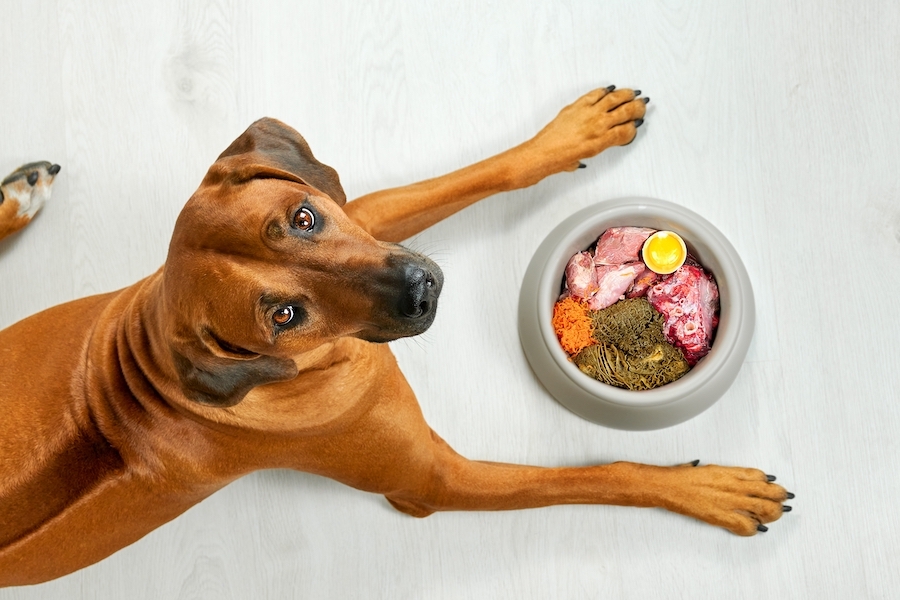Is The Wolf Diet for Dogs Similar to The Paleo Diet for Humans?

There’s no doubt that The Paleo Diet® has helped many recover their health and vitality. But does the concept of an ancestral diet work for your pets?
If you have a dog, you probably want to help them get the same energy and longevity that you’ve enjoyed on The Paleo Diet. But before you feed your pup the same nutrient-dense foods that have worked for you, consider that the nutritional needs of dogs are quite different.
This question was at the forefront of Jaron Lukas’ mind when he founded his natural pet food brand, yumwoof! He borrowed the ethos of a “wolf diet” to create a dog food blend that your pup was designed to eat. But, it wasn’t as simple as just recreating a wolf’s diet since dogs have evolved significantly through breeding from their ancient ancestors. He also had to follow what science says about modern canine health.
“I grew up on processed foods like cereal—which I cut out of my diet after learning the benefits of The Paleo Diet,” says Lukas. “Well guess what – your dog’s dry kibble is made in the same machine as cereal, with highly inflammatory ingredients! That’s why it’s worth looking at the wolf diet—basically The Paleo Diet for canines—for guidance on their biologically appropriate diet.”
Jaron sat down with us to answer a few of our questions:
The Paleo Diet: What should our readers know about the wolf diet?
Jaron: The first thing to know about the wolf diet is the broad macros. A wolf’s diet is approximately 54% protein, 45% fat and 1% carbohydrates (although studies show dogs can eat up to 20% carbs without any negative impact on long term health.).
Dogs are adapted to a high protein, high fat diet. Furthermore, studies show that dogs can handle extremely high levels of saturated fat without any negative effect on heart health.
Unfortunately, most dry kibble contains 40% to 70% carbohydrates—way higher than what’s biologically appropriate for canines. Additionally, the fats used in most dog food tend to contain inflammatory vegetable oils, which should also be avoided.
The Paleo Diet: What’s the most interesting fact about the wolf diet?
Jaron: Wolves eat the stomach of their prey first, because that’s where the most vitamins and minerals are. It’s also where they naturally eat foods like berries, grasses, and vegetables.
That’s why even raw diets contain ingredients besides meat. It’s important to make sure your dog has a nutritionally balanced diet. A recent study showed 95% of homemade recipes are deficient in at least one nutrient. When using the wolf diet to frame your dog’s nutrition plan, it’s important to remember that they didn’t only eat meat.
The Paleo Diet: Would you say the wolf diet is right for dogs today?
Jaron: The wolf diet is certainly a great framework for canine nutrition. That said, the digestive system of dogs has evolved over 30,000 years of living with humans. I tend to look to NIH studies to understand what ingredients dogs should eat.
Generally speaking, a high protein, high fat diet is ideal for dogs—but ingredients high in antioxidants and omega-3 fatty acids are undeniably good for modern dogs, even though they’re not technically in a wolf’s diet. The ability to feed those ingredients is one of the benefits of living in the modern world of abundant food options.
The Paleo Diet: Interesting! So what proteins should dogs eat based on the wolf diet?
Jaron: Wolves generally eat hooved animals, like deer and elk, but they also hunt smaller animals, like rodents and hares. Given their ancestral protein preference, it’s not surprising that dogs are prone to chicken allergies, especially if they’re exposed to eating it every day.
The most common hooved animal protein in dog food is beef. Dogs also have very low allergy rates to eating pork and fish.
The Paleo Diet: Last question, but perhaps the most important. What’s the most underrated part of the wolf diet?
Jaron: Feast and famine. While dogs don’t go into ketosis the same way humans do (simply keeping their carbs low isn’t enough—they literally have to starve for 3 days), dogs are still not built to eat three meals a day.
Intermittent fasting and the occasional 24-hour fast are the best ways to help keep your dog’s body as healthy as possible, according to their ancestral eating patterns.
Jaron Lukas is the CEO and founder of yumwoof! natural pet food, a maker of non-GMO, air-dried dog food personalized to your dog’s breed.
The Paleo Diet Team
The Paleo Diet® team consists of a group of scientists, journalists, experts, and recipe creators who stay at the forefront of nutrition science.
More About The Author




